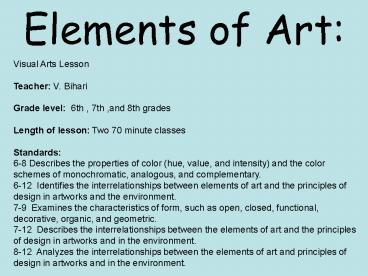Elements of Art: PowerPoint PPT Presentation
1 / 11
Title: Elements of Art:
1
Elements of Art
Visual Arts Lesson Teacher V. Bihari Grade
level 6th , 7th ,and 8th grades Length of
lesson Two 70 minute classes Standards 6-8
Describes the properties of color (hue, value,
and intensity) and the color schemes of
monochromatic, analogous, and complementary. 6-12
Identifies the interrelationships between
elements of art and the principles of design in
artworks and the environment. 7-9 Examines the
characteristics of form, such as open, closed,
functional, decorative, organic, and geometric.
7-12 Describes the interrelationships between
the elements of art and the principles of design
in artworks and in the environment. 8-12
Analyzes the interrelationships between the
elements of art and principles of design in
artworks and in the environment.
2
Elements of Art
Procedures Use interactive board and PowerPoint
advance to lead a review of the elements of art.
Students will compare their vocabulary study
guide to the vocabulary on the presentation.
Evaluation Students will be tested over the
elements of art. Materials Active
board PowerPoint presentation Pencils Elements of
art test Test answer sheets Modifications
Assist all students as needed.
3
Elements of Art the basic visual symbols an
artist uses to create works of art. They are
line, color, value, shape, form, space, texture
4
zigzag- diagonals joined in opposite
directions- action, nervous excitement
Line The path of a dot through space.
diagonal- straight lines that slant- -movement
curved- change direction little by
little- graceful movement
vertical- up and down- strength, permanance
horizontal- side to side- peace, rest
5
Color what the eye sees when light is
reflected off of an object. The three
properties of color are hue, value, and
intensity
6
Monochromatic colors tints and shades of a
single hue.
Hue a colors name.
Warm colors colors that remind you of heat
(reds, yellows, oranges)
Primary hues (colors) pure colors colors used
to mix all other colors.
Cool colors colors that remind you of cold
(blues, violets, greens)
Secondary hues the mixture of two primary
colors.
Analogous
Intermediate colors the mixture of a primary
color with a secondary color.
Complementary colors opposites on the color
wheel
complementary
Analogous colors side by side on the color
wheel and have a color in common.
7
Value lightness or darkness of a hue.
Intensity brightness or dullness of a hue.
8
Shape an area clearly set off by one or more
of the other six visual elements of art.
Geometric shape precise, mathematical, appear
to be made with a tool.
Organic shape not regular or even, often found
in nature.
9
Form an object with three dimensions.
Geometric form precise, mathematical, appear to
be made with a tool.
Organic form not regular or even, often found
in nature.
10
Space the distance or area above, below,
between, around, and within things.
The six techniques artists use to create the
illusion of deep space in 2-dimensional art are
Linear perspective the lines of roads,
buildings, and similar objects are slanted
towards each other this makes them appear to
come together in the distance.
Overlapping nearer objects partly cover, or
overlap, those that are farther away.
Size closer objects are larger than those meant
to appear in the distance.
Placement nearer objects are palced lower in the
picture than those meant to appear in the
distance.
Intensity and value objects that are meant to
appear in the distance are lower in intensity and
lighter in value than closer objects.
Detail more detail is added to objects that are
meant to appear closer, less to those farther
away.
11
Texture how things feel or look as though they
might feel when touched.
Tactile texture texture you can actually feel.
Visual texture texture you can see but not feel.

